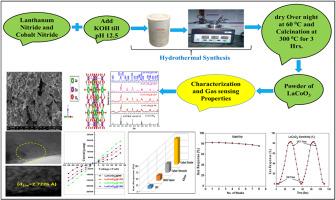Development of LaCoO3 based thick film sensors for selective CO2 detection in greenhouse gas monitoring
IF 3.4
4区 化学
Q2 CHEMISTRY, MULTIDISCIPLINARY
引用次数: 0
Abstract
This study explores the potential of lanthanum-based LaCoO3 perovskite oxide as a thick-film gas sensor for carbon dioxide (CO2) detection. LaCoO3 was synthesized via a hydrothermal method at varying temperatures (90, 120, 150, and 180 °C) to optimize the material properties for gas sensing applications. The synthesized powders were formulated into pastes and screen-printed onto glass substrates using a suitable binder to fabricate thick films. Structural characterization using X-ray diffraction (XRD) confirmed the formation of nanostructured LaCoO3 with a hexagonal phase, exhibiting an average crystallite size between 20.14 nm and 23.85 nm. Surface morphology was examined using scanning electron microscopy (SEM), while transmission electron microscopy (TEM) provided nanoparticle size information. The elemental composition was verified through energy-dispersive X-ray spectroscopy (EDAX). Optical properties, including bandgap energy (1.49–1.73 eV), were analyzed using UV–visible spectroscopy. Fourier-transform infrared (FT-IR) spectroscopy identified the vibrational modes associated with M − O bonding. The gas sensing performance of the LaCoO3 thick films prepared from materials synthesized at varying hydrothermal reaction temperatures (90, 120, 150, and 180 °C) was evaluated against various greenhouse gases (CO, CO2, HFCs, and water vapor) under different operating temperatures (400, 350, 300, 250, 200, 150, 100, 50 and 33 °C) and concentrations (100, 300, 500, 800, 1000 and 1200 ppm). The sensor exhibited the highest response to CO2 at 250 °C and 1000 ppm, along with rapid response and recovery times. Parameters such as gas response, selectivity, and response behavior were systematically assessed. The enhanced sensing performance is attributed to the intrinsic properties of LaCoO3, highlighting its promise for CO2 detection in environmental monitoring applications.

温室气体监测中选择性CO2检测用LaCoO3厚膜传感器的研制
本研究探索了镧基LaCoO3钙钛矿氧化物作为二氧化碳(CO2)检测厚膜气体传感器的潜力。通过水热法在不同温度(90、120、150和180°C)下合成LaCoO3,以优化材料性能,用于气敏应用。将合成的粉末配制成糊状,并使用合适的粘合剂丝网印刷到玻璃基板上以制造厚膜。采用x射线衍射(XRD)对其进行了结构表征,证实形成了六方相的LaCoO3纳米结构,平均晶粒尺寸在20.14 ~ 23.85 nm之间。使用扫描电子显微镜(SEM)检查表面形貌,而透射电子显微镜(TEM)提供纳米颗粒尺寸信息。通过能量色散x射线光谱(EDAX)对元素组成进行了验证。光学性质,包括带隙能量(1.49 ~ 1.73 eV),利用紫外可见光谱分析。傅里叶变换红外光谱(FT-IR)鉴定了与M−O键相关的振动模式。在不同的水热反应温度(90、120、150和180℃)下合成的LaCoO3厚膜对不同温度(400、350、300、250、200、150、100、50和33℃)和浓度(100、300、500、800、1000和1200 ppm)下的温室气体(CO、CO2、hfc和水蒸气)的气敏性能进行了评价。该传感器在250°C和1000 ppm时对CO2的响应最高,并且具有快速的响应和恢复时间。系统地评估了气体响应、选择性和响应行为等参数。增强的传感性能归因于LaCoO3的固有特性,突出了其在环境监测应用中二氧化碳检测的前景。
本文章由计算机程序翻译,如有差异,请以英文原文为准。
求助全文
约1分钟内获得全文
求助全文
来源期刊
CiteScore
3.50
自引率
7.70%
发文量
492
审稿时长
3-8 weeks
期刊介绍:
The Journal of the Indian Chemical Society publishes original, fundamental, theorical, experimental research work of highest quality in all areas of chemistry, biochemistry, medicinal chemistry, electrochemistry, agrochemistry, chemical engineering and technology, food chemistry, environmental chemistry, etc.

 求助内容:
求助内容: 应助结果提醒方式:
应助结果提醒方式:


